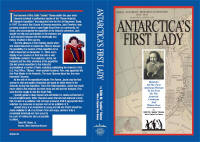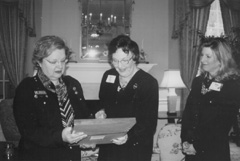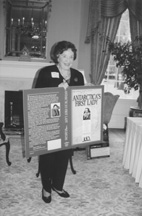|
|
The Ronne Family







 "Antarctica's
First Lady" "Antarctica's
First Lady"
newly released autobiography by
Edith M. "Jackie" Ronne
Member, Ronne Antarctic Research
Expedition (1946 - 1948)
Memoirs of the first American woman to set
foot on the Antarctic Continent and the first woman to winter over as a
working member of a pioneering Antarctic expedition. That was her
husband's Ronne Antarctic Research Expedition, 1946-48. She was a
witness to the fascinating days of polar exploration. Ronne Ice Shelf was
named for her.
Purchase Price: $20.00. large paperback
(please add an additional $5.00 for packaging and postage, thanks!)
To order book, send a check to "Karen
Ronne Tupek"
and mail to:
Karen Ronne Tupek
Summer: 4956 Sentinel Drive #101, Bethesda, MD 20816
Fall, Winter, Spring: 4270 NE 23rd Terrace, Lighthouse Point, FL
33064
For a printable order form
to fill out and mail with payment: click
HERE
For payments
using PayPal, click here:
Book Summary
As she left home her
suitcase contained little more than a good suit, a good dress, nylon
stockings, and high heeled shoes. But she had the excuse that she didn’t
know she was going for a year’s expedition to Antarctica. Little did
Jackie Ronne realize this was the beginning of a series of events that led
her to make history and to become a unique celebrity, as well as an
important woman pioneer. The year was 1947.
This book is a personal
account by the first American woman to set foot on the earth’s seventh
continent, and the first woman ever to be a working member of a pioneering
expedition to explore the vast Antarctic wilderness. This historic
achievement is recognized in a truly extra-ordinary way, one usually
accorded only to women of royal birth: the Ronne Ice Shelf, the world’s
second largest, is named for her.
This first-hand chronicle
includes her upbringing as well as the background of her Norwegian
husband’s polar heritage, one she was destined to follow. She shares her
personal insights, fears, reactions, and emotions about the unfolding
events on an expedition that made important geographical and scientific
discoveries, as well as human drama. Her recounting of the expedition
features many excerpts from her expedition diary and highlights the day to
day workings of this small-scale but ambitious expedition. The struggles
of this group of scientists, ship’s crew, and maintenance personnel are
punctuated by the challenges of maintaining cordial interpersonal
relationships in severe isolation.
Men rebelled; other members
retaliated; a pilot was fired, but remained in camp; a meteorologist fell
into a crevasse, miraculously escaping death; another pilot walked into a
rotating propeller and lived; the first mate fell off a high cliff into
the icy seas; - all set against the meticulous scientific exploration
that took place in and around the most dramatic, dangerous, yet beautiful
scenery in the world. It is a classic study of human endurance and a
compelling tale.
Background:
Martin Ronne, her husband’s
father, had been a member of Norwegian explorer, Roald Amundsen’s
expedition. He made the small tent that Amundsen left at the South Pole
signifying his December 14-17, 1911, arrival. Martin remained with
Amundsen through twenty years of polar exploration and subsequently became
the only member of Admiral Richard Byrd’s first expedition who had ever
been to Antarctica before. Upon Martin’s death in 1931, his son, Finn
Ronne, immediately followed in his father’s footsteps as a natural
extension of his Norwegian heritage. Finn accompanied Admiral Byrd on his
second expedition and was soon hooked on the polar regions. He helped
organized a U.S. government expedition in 1940, when he sited and built
the camp of four buildings that later also became home to the Ronne
expedition. The smallest hut, 12’ x 12’, became Jackie’s home for a year.
How Jackie Made History:
When Jackie’s husband,
Captain Finn Ronne, first organized the Ronne Antarctic Research
Expedition in 1946, she intended to handle its affairs Stateside. While
bidding her husband good-bye during the hectic departure, he asked Jackie
to help with the last minute details, in increments while they headed
south. Finn ultimately persuade her to accompany his expedition as
Historian and Correspondent for the North American Newspaper Alliance. To
avoid becoming the “first and only,” another woman went as well, but had
no official expedition role. As she gathered last minute supplies in
Chile, Jackie resigned from her State Department position, and a new
future awaited.
Jackie’s Experience on The Ronne
Antarctic Research Expedition:
Jackie was completely
unprepared for the truly magnificent scenery of that desolated southern
continent. She writes,
“Once within the Antarctic Circle, our 183 foot, wooden hull ship slowly
made her way through the light pack-ice belt that surrounds the Continent
at all times. Under the brilliant sun, the shimmering icebergs and the
snowcapped mountain peaks stood in great contrast to the vivid blue sky
and cobalt sea. Heavily crevassed glaciers descended through the majestic
mountain passes ending in a 200 foot high frozen ice shelf which, with few
exceptions, encircles the 5,200,000 square mile land mass.”
Once their ship was securely
anchored in a cove off Stonington Island, in Marguerite Bay, they moved
ashore scientific equipment, food for two years, dogs, three airplanes,
gasoline, 30 tons of coal, and innumerable other materials. The 12-foot
square hut she shared with her husband connected to the mess hall bunk
house by a short tunnel. During the long dark winternight, she learned
first hand of the tedious hard work required to carry on investigations in
twelve branches of science under harsh polar conditions. Later, Jackie
assisted their geophysicist in some of his work and wrote many articles
describing expedition progress for radio transmittal to the N.Y. Times.
For recreation, they watched movies, listened to music, read, played
games, and skied on the adjacent glacier.
But the
thrust of this book is her diary, which recorded the daily progress of the
expedition, as well as how men act in isolation, revealing their petty
jealousies and childish antics to get what they wanted or else revenge.
Tensions built up during the long dark winternight and took their toll.
Originally, they had no agenda of their own, but once away from
civilization, personalities change, developing their own desires, petty
jealousies, and childish antics to get what they wanted while jeopardizing
relationships and the goals of the expedition. In the end, it was triumph
over adversities of two kinds – the harsh elements of the Antarctic and
the psychological stress of isolation.
In recognition of the
family’s long involvement in Antarctic exploration, Jackie and Finn were
invited by the Department of Defense on a flight to the South Pole in
December 1971, honoring Amundsen’s 60th anniversary of reaching the Pole.
They became the first husband and wife team to set foot at the South
Pole. This was her husband’s ninth and last journey south over a 38 year
span, including four overwinterings. But it was not to be the last one
for Jackie, as she continues to be drawn back to the haunting beauty and
abundant animal life that characterizes the frozen continent at the end of
the earth, making three more trips as a lecturer on cruise ships with
destination: ANTARCTICA.
Antarctica’s
First Lady
by
Edith M. “Jackie” Ronne
Book Summary
I started out for a year's stay on the Antarctic
continent with one small suitcase that held a good suit, a good dress,
nylon stockings and high heel shoes - clothes about as suitable as Eskimo
furs on a South Sea Island. But I had the excuse that I didn't know I was
going until the last moment; my husband, the leader of The Ronne Antarctic
Research Expedition (1946-48), finally persuaded me that he needed me.
This book is my personal account as the first American woman to set foot
on the earth’s seventh continent and the first woman ever to have been a
working member of an Antarctic Expedition.
Although I had lived vicariously through my husband’s
previous Antarctic expeditions, I was completely unprepared for the truly
magnificent scenery of that southern continent. Under the brilliant sun,
the shimmering icebergs and the snow-capped mountain peaks languished
against the vivid blue sky and a cobalt sea, punctuated with the antics of
penguins. Little did I know what was to come: a meteorologist fell into a
crevasse; a pilot walked into a rotating propeller; a small plane from a
nearby British base crash landed in unknown territory without a radio; Men
rebelled; others retaliated; a pilot was fired, but remained in camp;
attempts were made at sabotage; and a pilot’s wife who had been taken
along as my companion ended up barely speaking to me. There were many
times I wondered how I had ever been talked into coming and counted the
months until we would be heading north once more.
Against the back-drop of human drama, the
expedition made important geographical and scientific discoveries. Upon
the return, the U.S. Board on Geographic Names called the largest newly
discovered area, Edith Ronne Land. Today it is known simply as the Ronne
Ice Shelf.
For
nearly fifty years, people have asked me why I haven’t written a book
about my Antarctic experiences. I have lectured widely and written
articles but have never revealed how I personally felt. It was, in many
respects, too painful. As the expedition leader's writer, confidant, and
wife, I was in a unique position to understand his plans, motivations, and
frustrations. My husband had put his very being into the expedition and my
only interest was the venture's success. His worries were my worries. He
was not new to the inevitable expedition controversies; I was and it
created enormous tension for me the entire time. When I viewed the Statue
of Liberty in New York Harbor upon our return, I knew the gratitude and
relief of the most desperate refugee ever to enter the United States. I
kept a very complete diary that year but as I had neither the desire nor
courage to relive the experience, it took me forty-seven years to read it
again. This book is the result. I include many rarely seen and previously
unpublished photographs. Perhaps more importantly, however, for the first
time, through a mixture of diary extracts and narrative, I share my
personal insights, fears, reactions and emotions about the unfolding
events of the last private pioneering expedition to explore the vast
Antarctic wilderness
Introduction
or nearly fifty years, people have asked
me why I did not write a book about my Antarctic experiences, particularly
those that took place on the Ronne Antarctic Research Expedition. I kept
a very complete diary for that year which has never been published. In
fact, it took me forty-seven years before I had the desire or courage
enough to read it again. I had not wanted to relive the experience so
closely again. After many years had passed and I was no longer so
emotionally involved, I realized as the wife of the expedition’s leader I
was the only one who could tell this story. Not only is this an
historical account of the human triumphs and deficiencies of men and women
in isolation on this particular expedition, but an example of the
break-down of human reaction of people in isolation on expeditions past
and present throughout history.
Over the years, I have talked, written and
lectured widely about my experiences on the expedition, but I have never
once revealed how I personally felt about them. It was too hard, too
close to me; in many respects too painful. When I finally mustered the
courage to face the day to day occurrences written in my diary and how I
felt about them at the time, I found my observations and reactions to the
things I lived through far more fascinating now than the day I recorded
them. This is my accurate account of my observations, what I lived
through, and how I felt about it.
For me, the trip was an extremely
difficult experience. As the wife of the leader who had put his very
being into the planning and execution of the expedition, my only and
complete interest was the success of the venture. His worries were my
worries. He was not new to the inevitable expedition controversies. I
was. I was under enormous tension the entire time. It took its toll. I
lost weight and returned to civilization at the lowest weight of my adult
life. When I viewed the Statue of Liberty in New York Harbor upon our
return, I knew the gratitude and relief of the most downtrodden refugee
ever to have immigrated to the United States. I had not wanted to go in
the first place. Had I known what it would be like, I would not have
gone, or certainly would have made different decisions before I did go.
Upon return, I said immediately, I would never go again, that I knew the
grass was not greener on the other side of the fence.
On the other hand, I realize that
participating in the expedition made my life. It opened up vistas and
opportunities that I never would have had otherwise. It’s been my career
too. I have written and lectured about it extensively and I have returned
to the Antarctic continent several times. Old time explorers were all
captivated by the beauty, the isolation, and nature in the raw.
Invariably, they all wanted to return in time. So it had been with Finn
and so it was with me. The first time I returned was in 1959 and in 1971,
Finn and I were the first husband and wife team to set foot at the South
Pole. Also I returned to lecture on cruise ships in early 1995 and again
in 1996. And so in retrospect, since I have finally recorded the story of
my historic year’s stay there, I have no regrets and am relieved at having
completed the saga.
Edith M. “Jackie” Ronne
Bethesda, Maryland
January 1996
| Antarctica's First
Lady Comes to Texas |
On November 11, 2004, Edith “Jackie” Ronne attended
Girl Scouts of San Jacinto Council’s Power of a Promise Breakfast. A
former Girl Scout and Sea Scout, Jackie was the first American woman
to set foot and winter on the Antarctic continent. She accompanied her
husband, polar explorer Finn Ronne on his fifteen-month Ronne
Antarctic Research Expedition. The expedition left the Port of
Beaumont on January 25, 1947. It was the last private volunteer
expedition from the United States of America.
 As Expedition
Recorder-Historian, she wrote news releases for the North American
Newspaper Alliance, and kept a daily history of the expedition’s
accomplishments. She has served as president of the Society of Women
Geographers and is the recipient of a special Congressional Medal for
American Antarctic Exploration. She has recently published a book,
Antarctica’s First Lady, about her experiences that includes excerpts
from her personal diary describing daily life and the challenges the
explorers faced. As Expedition
Recorder-Historian, she wrote news releases for the North American
Newspaper Alliance, and kept a daily history of the expedition’s
accomplishments. She has served as president of the Society of Women
Geographers and is the recipient of a special Congressional Medal for
American Antarctic Exploration. She has recently published a book,
Antarctica’s First Lady, about her experiences that includes excerpts
from her personal diary describing daily life and the challenges the
explorers faced. |

Jackie's book describes her experiences as an
Arctic explorer. |
|
 After
the breakfast, Cora Ann Blytas presented Jackie with a proclamation
from Houston Mayor Bill White, marking November 11 as Edith “Jackie”
Ronne Day. Jackie took time to sign copies of her book for fans. Later
in the afternoon she traveled to the Clifton Steamboat Museum Complex
in Beaumont to celebrate the opening of the Ronne Museum Exhibit.Edith
“Jackie” Ronne exemplifies the ideals of the Girl Scouts founder,
Juliette Gordon Low. Her pioneering spirit, intellectual curiosity and
sense of adventure represents the best of what Girl Scouting is about.
It was a truly memorable day. After
the breakfast, Cora Ann Blytas presented Jackie with a proclamation
from Houston Mayor Bill White, marking November 11 as Edith “Jackie”
Ronne Day. Jackie took time to sign copies of her book for fans. Later
in the afternoon she traveled to the Clifton Steamboat Museum Complex
in Beaumont to celebrate the opening of the Ronne Museum Exhibit.Edith
“Jackie” Ronne exemplifies the ideals of the Girl Scouts founder,
Juliette Gordon Low. Her pioneering spirit, intellectual curiosity and
sense of adventure represents the best of what Girl Scouting is about.
It was a truly memorable day.
|
|